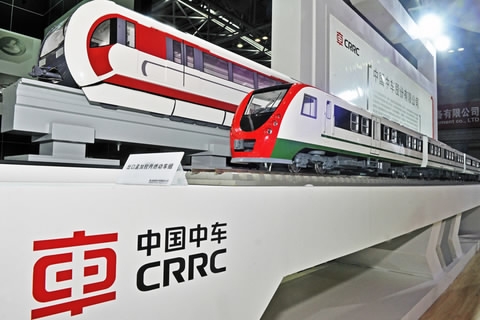
World
20:12, 27-Sep-2017
Siemens, Alstom merges, as a counterweight to China’s CRRC
By CGTN's Song Yuanyuan

German industrial group Siemens and French rival Alstom agreed on Tuesday to merge their rail operations, creating a European champion to better compete with Chinese state-owned CRRC which is moving fast for the lucrative European market.
"This Franco-German merger of equals sends a strong signal in many ways. We are creating a new European champion in the rail industry for the long term. This will give our customers around the world a more innovative and more competitive portfolio," said Joe Kaeser, president and CEO of Siemens AG.
According to an Alstom statement, the group headquarters will be in the Paris area and 50 percent of the shares in the new entity will be owned by Siemens. The board of directors will consist of 11 members, six of whom will be designated by Siemens, including the chairman. Henri Poupart-Lafarge from Alstom will serve as chief executive, countering criticism that France is giving up control of another national industrial icon.
The Alstom-Siemens merger has been mooted for years and completes the transformation of the French group which sold off its energy business to American rival General Electric in 2015 for 9.5 billion euros (11.3 billion US dollars), AFP reported.
The deal is a blow to Canadian transportation group Bombardier, which also held negotiation talks with Siemens, as media reported, and this week is trying hard to protect jobs in Quebec and Northern Ireland.
Can this alliance withstand China's CRRC?
The Siemens and Alstom transport businesses, which span the French TGV and German ICE (InterCity Express) high-speed trains as well as signaling and rail technology, had combined sales of about 15 billion euros (18 billion US dollars) in their last fiscal years.
But CRRC's revenues topped 18 billion euros (21.4 billion US dollars) last year more than the two combined together. The Chinese company’s lower cost base is a big advantage: A Siemens-built high-speed train costs around 40 million euros, but for CRRC, the cost is just 19 million euros.
The two’s alliance comes as a better withstand to CRRC, a rail giant created by a state-directed merger in 2015 and is now aiming for the European market. It’s currently completing a takeover of the Czech train manufacturer Skoda after previously only scooping up smaller European firms such as German parts supplier Bochumer Verein.

photo from public pool
photo from public pool
”Although, Skoda as an old European electric locomotive brand, has lost its glamour amid today’s fierce competition, it still has some technology and employee advantages, producing facilities that meet all of Europe’s standards requirements. So primarily, it can offer CRRC detailed knowledge of the European regulatory environment, helping it further tapping into the European market.” Dr. Li Honghan, a research fellow at the Collaborative Innovation Center of Industrial Upgrading and Reginal Finance (Hubei) told CGTN.
Potential pressures for CRRC
“But the two groups’ alliance poses challenges for CRRC too, in that the merge adds geographical advantages for each other. While Siemens has prominent market shares in China, the US, and Russia; Alstom is more prominent in the markets of Middle East, Africa, India, Central and South America. And those areas are where China’s CRRC is trying to explore more market shares as well.” Dr Li talked about the pressures for CRRC due to the merge.
“Secondly, the two both owning leading rail technologies, their merge will also help them create more proprietary technology, posing another challenge to CRRC,” Li added.
“Notably, CRRC is a very important and leading company participating in China’s Belt and Road Initiative in its overseas expansions. It should also pay attention to the local regulations, laws, and culture in acquisitions,” Li noted.

SITEMAP
Copyright © 2018 CGTN. Beijing ICP prepared NO.16065310-3
Copyright © 2018 CGTN. Beijing ICP prepared NO.16065310-3